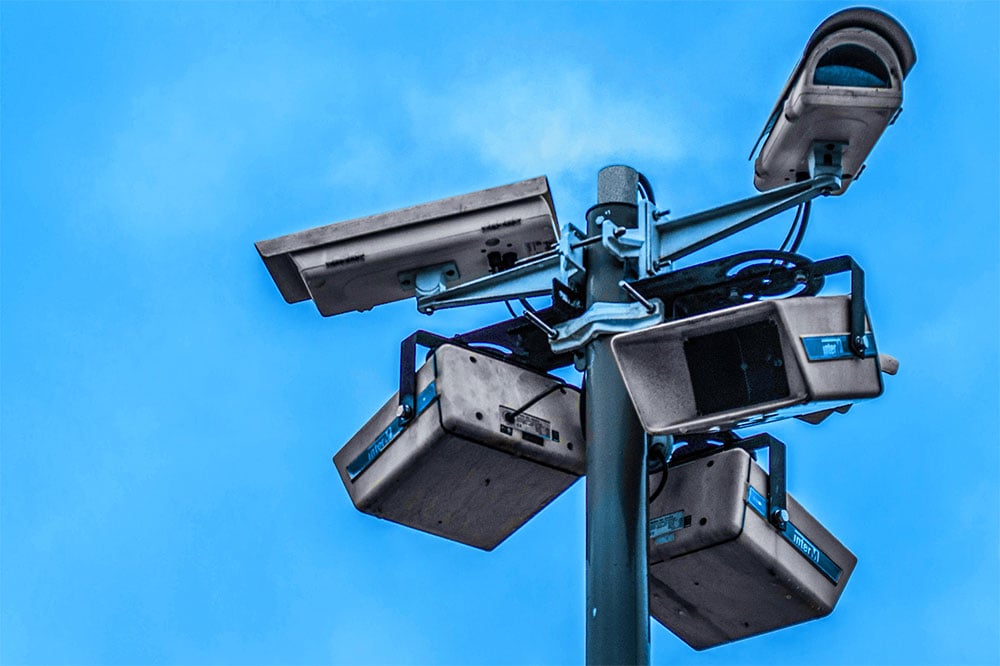U.S. Current Trend: Surveillance Technologies
Surveillance and the Right to Protest
The emergence of new surveillance technologies has raised concerns about their potential abuse by U.S. law enforcement authorities, including inappropriate surveillance of demonstrations. The use of new surveillance technologies can have a chilling effect on protesters and protest organizers by infringing on their rights to privacy and peaceful assembly.
This U.S. Current Trend briefly examines three types of surveillance technology that have disconcerting implications for protestors: (1) cell-site simulators, (2) facial recognition software, and (3) drones and other aerial equipment. It ends by highlighting measures to strengthen community control over police surveillance, which have been enacted by some municipalities concerned about issues of privacy and freedom of assembly posed by these and other surveillance technologies.

CELL-SITE SIMULATORS
Cell-site simulators, or stingrays, are devices that mimic legitimate cell phone towers and trick cell phones into connecting with them. Cell-site simulators can be used to identify cell phones in a given area and intercept meta-data such as the numbers and the duration of any calls placed. Cell-site simulators can also be used to track a cell phone’s text messages and internet usage. They can target the cell phone of a specific individual or, in dragnet style, track all cell phones in the surrounding area.
Police departments around the United States have been quietly using cell-site simulators. (This map by the American Civil Liberties Union shows the current locations of state and local police departments known to own them.) One of the first police departments to purchase cell-site simulators was the Miami-Dade Police Department, which acquired them to monitor protests at the 2003 summit on the Free Trade Area of the Americas. There is anecdotal evidence that other law enforcement agencies have used cell-site simulators to track protests as well.
The ability of law enforcement agencies to use cell-site simulators to track protests has potentially worrying consequences. Such measures may deter individuals from participating in protests if they worry that their privacy will be violated or persons taking part in a protest can be inappropriately identified and implicated if a handful of demonstrators engage in illegal behavior.
Concerned about the potential abuse of cell-site simulators, the courts have recently begun to restrict their use. In September 2017, the District of Columbia’s Court of Appeals ruled that the use of cell-site simulators requires a warrant. This ruling followed similar rulings by other state courts that had considered the issue and guidance released by the Justice Department.
While civil liberties advocates welcome these limitations on the use of cell-site simulators, it is not clear that they go far enough. Some law enforcement agencies have signed non-disclosure agreements with companies that lease cell-site simulators, requiring that the agency using them will not publicly acknowledge they own the technology. If the public does not know that a city has stingrays, it will be difficult to monitor whether the technology is being abused.
FACIAL RECOGNITION
As public cameras proliferate in communities across the country, concern is growing about the abuse of facial recognition software. Protesters may be less likely to attend a demonstration if they know that law enforcement agencies can identify and monitor them using facial recognition software. Databases storing information on persons who have been identified with the technology can be leaked or hacked, allowing lists of those who have attended protests to end up in the public domain. Importantly, the information collected may not even be accurate, as facial recognition software is known to be susceptible to error. The threat that facial recognition software poses to the freedom of assembly, among other concerns, has led some civil liberties groups to recommend stricter regulation of this technology, including requirements that users obtain judicial authorizations and limiting its application to serious crimes.
DRONES & AERIAL SURVEILLANCE
Law enforcement agencies’ acquisition of drones has raised concerns about their use to monitor protests. Unlike helicopters, which are also used to monitor protests, drones are more affordable and can fly in closer to demonstrations. They are able to hover above crowds, not only to take pictures but also to record video and audio clips of protesters. The data that drones capture can be coupled with facial recognition software to allow police to identify large numbers of individual protesters in real time.
As of 2017, eighteen states required law enforcement agencies to obtain search warrants before using drones for surveillance or searches. Vermont’s legislation explicitly bars law enforcement agencies from using drones to “gather or retain information on private citizens peacefully exercising their constitutional rights of free speech and assembly.” Most states, however, have not passed legislation to regulate the use of drones by law enforcement agencies during protests or at other times.
Illinois requires the police to obtain warrants before using drones for surveillance, but a bill introduced in 2018 would exempt drone surveillance of protests from this rule. The bill, which passed the Illinois House of Representatives but stalled in the Senate, was heavily criticized by civil liberties organizations, which warned that drones could be used to track and harass protesters and protest organizers.
Other aircraft equipped with camera technology can also be used to track protesters. In 2016, Bloomberg reported that the company Persistent Surveillance Systems provided aircraft surveillance services to the police department in Baltimore and used a plane equipped with specialized cameras that circled the city for hours. The cameras covered approximately thirty square miles and transmitted continuous real-time images to analysts on the ground. Such technology, particularly combined with other surveillance practices, can be used to track protesters and, as a result, discourage participation in demonstrations.
COMMUNITY CONTROL OVER POLICE SURVEILLANCE
In response to the acquisition of powerful new surveillance technologies by law enforcement agencies, some communities have passed laws to increase transparency and enhance community oversight of their use. (See the American Civil Liberties Union’s mapof localities that have passed or are working on such legislation.) In May 2018, for instance, Oakland passed a surveillance ordinance endorsed by civil liberties groups that requires the city council explicitly to approve any surveillance technology before the city acquires it. The ordinance also mandates an annual report detailing the city’s use of surveillance technologies, bans the city from entering into non-disclosure agreements that would prevent the public from knowing about the use of surveillance technologies, and creates a Privacy Advisory Commission.
Other localities in California, including Berkeley, Davis, and Santa Clara County, have adopted similar ordinances. Seattle also passed a surveillance ordinance in 2017 that includes the requirement that the city undertake a “surveillance impact report” and hold at least one public hearing before adopting any new surveillance technology.
These oversight mechanisms are helping communities reassert control over the use of surveillance technologies. As surveillance technologies multiply, it is important that governments adopt measures like these to ensure that their use does not infringe on privacy rights or undermine the right to peaceful assembly.
Last updated March 2019
For more information contact: Nick Robinson at nrobinson@icnl.org
To subscribe to US Program email updates, click here.
Sign up for our newsletters
Sign up